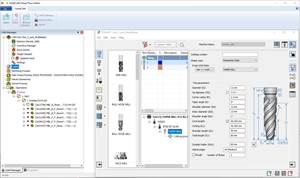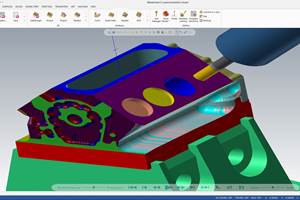CAD/CAM Software Helps Manufacturer Keep Pace With Increased Work Loads...
With new Swiss-type CNC lathes slated to be this company's major producers, the owner knew he needed a programming system that would be able to quickly generate programs for the Swiss-type's unique programming requirements, in addition to being able to handle his existing milling and turning centers.
In front of manufacturing engineer Mark Peniska stood a unique programming challenge. In addition to its large horizontal and vertical tombstone mills and lathes with live-tooling, his company, Isco Inc. (Lincoln, Nebraska), had just taken delivery of two new nine-axis CNC Swiss-type lathes. Isco manufactures a wide range of water monitoring equipment and chemical separation instruments.
With the new Hardinges slated to be the company’s major producers, Mr. Peniska knew he needed a programming system that would be able to quickly generate programs for the Swiss-type’s unique programming requirements in addition to being able to handle Isco’s existing milling and turning centers.
Isco’s existing combination of CAM package and manual programming just would not allow its CNC programmers and operators to keep pace with the company’s increased manufacturing capacity. The company knew it was time to make a move. In looking at the field, Isco found only one system that fit the bill, PartMaker from IMCS, Inc. (Fort Washington, Pennsylvania). “The main feature that sold us on PartMaker was its ability to program Swiss-type lathes,” says Mr. Peniska. The company also liked that PartMaker handled Sync codes and generated the output of two separate programs needed to control the Swiss turn operations.
Isco has focused on bringing more of its production process in house while cutting the cycle time on the range of small and large parts it produces. The company has made an investment in multifunction CNC machines that can produce complete parts with a minimum amount of secondary operations.
Like many manufacturers, Isco has come to embrace the philosophy of setup and cycle-time reducing multifunction equipment. The company knows programming is an important aspect too. “If you’re buying new machines that reduce cycle time, why keep your part programming in the dark ages?” says Mr. Peniska, “That doesn’t make any sense.”
“PartMaker’s ‘divide and conquer’ approach to programming turn-mill centers and Swiss-type lathes makes it an intuitive and easy-to-use CAD/CAM system for programming multi-axis lathes with live-tooling,” says Alan Christman, vice president of CAD/CAM industry consultant CIMdata. The ‘divide and conquer’ programming strategy, called Multiple Faces Programming, helps the programmer deal with complicated parts by breaking their surfaces into a set of faces. A part face contains various machined features such as slots or holes. These faces maybe planar or rotational. A specific machining function such as turning, polar milling or cylinder milling is assigned to each face. A dedicated window contains a graphic representation of the face features.
For milling applications, PartMaker’s ability to generate a separate face for every plane on a tombstone or angled faced on an indexing head gives the programmer the ability to optimize programs in a visual manner. The programmer can choose to perform all the machining functions on one part face and then move to the next or use one tool on every face and then change tools to optimize for tool change time.
“Without Multiple Faces Programming, I don’t know what I would have done. I would have had to do a lot of cutting and pasting,” says Mr. Peniska. “Our manufacturing philosophy is to optimize tombstones for tool change time. PartMaker allows us to keep track of the various faces on each tombstone and generate a single optimized G-code program.”
PartMaker is a knowledge based machining system, allowing it to provide a substantial gain in programming efficiency by remembering the tools, material and process information necessary to machine individual part features. It thus relieves the user from re-entering the same features information for subsequent parts. It also improves productivity by placing the emphasis on tool management functions.
“Continuity used to be a big problem in our lathe department,” says Mr. Peniska. “The programmer would have to remember everything about old programs and keep track of his data. With knowledge based machining, we no longer have to rely on notes to remember things like the feeds and speeds we use on exotic materials. PartMaker keeps track of them for us.”
The key to PartMaker is its visual programming approach. It assures quicker learning and easier use. It makes extensive use of pictures to help the user describe tools, part features and machining data. Parameters, such as angle, diameter, depth of cut, clearance and finish allowance are clearly marked for easy entry.
In order to validate the correctness of the final CNC program, a 3D solid model simulator reproduces cutting tools’ movements in the process of material removal and the shaping of a workpiece into a machined part.
“PartMaker has cut my programming time for the mill in half,” says Mr. Peniska. “In some cases, I can make programs that would have taken four hours before in less than an hour.” MMS
Related Content
How this Job Shop Grew Capacity Without Expanding Footprint
This shop relies on digital solutions to grow their manufacturing business. With this approach, W.A. Pfeiffer has achieved seamless end-to-end connectivity, shorter lead times and increased throughput.
Read MoreAutomated CAM Programming – Is Your Software Really Delivering?
A look at the latest automation tools in Autodesk Fusion 360 software and how forward-thinking machine shops and manufacturing departments are using them to slash delivery times and win more business.
Read MoreBuilding A Powerful Bridge from the CAM Programmer to the Shop Floor Operator
SolidCAM for Operators provides a powerful bridge from CAM programming to the shop floor to best streamline the machine shop process with its CAM part simulation. It provides a clear picture to the operator for setup and prove-out, enables minor G-Code changes and avoids crashes, broken tools and scrapped parts.
Read MoreCAD/CAM System Requirements: An Overview
CAD/CAM programs are among the most demanding kinds of computer software. Smooth operation requires careful consideration of computer specifications.
Read MoreRead Next
3 Mistakes That Cause CNC Programs to Fail
Despite enhancements to manufacturing technology, there are still issues today that can cause programs to fail. These failures can cause lost time, scrapped parts, damaged machines and even injured operators.
Read MoreThe Cut Scene: The Finer Details of Large-Format Machining
Small details and features can have an outsized impact on large parts, such as Barbco’s collapsible utility drill head.
Read More

























